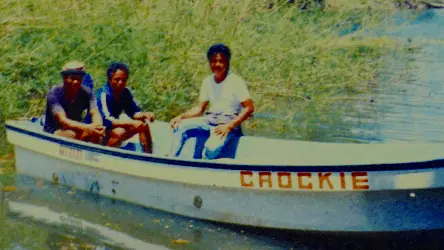Crocodiles are an important component of the aquatic ecosystem. To keep track of and manage their populations in the wild, spotlighting surveys are conducted. This article details how this is done.
Recalling those days I used to survey crocodilian population as part of my job, I thought of writing this article for those who are interested on how the population of these magnificent animals are being studied. There’s a rush of adrenaline every time I do the spotlighting survey with my team especially in areas where there are large crocodiles sighted. We do this at night along the river, from 6am to 12 midnight, amidst thick stands of mangroves for greater chance of seeing these nocturnal animals.
Materials for Crocodilian Survey
What materials are required to survey crocodilian population? Here is a list.
- A fiberglass boat with an outboard motor
- A bright spotlight with a 12-volt car battery
- Dark clothing
- A 3-meter pole with a diameter of about 1.5 inch diameter
Understanding the Risks of Dangerous Animal Surveys
Is it safe to survey these dangerous animals like the saltwater crocodile (Crocodylus porosus) in the wild? There are risks of course, but armed with an understanding of the behavior of crocodiles, there is no need to be too apprehensive. As long as you have presence of mind, you can ward off possible attacks.
Crocodiles are generally shy and wouldn’t attack a boat with bright spotlight at night as the only source of light. Unless it’s a very big male that tries to defend its territory from intruders. In fact, the use of the spotlight by crocodile hunters almost decimated wild crocodilian population in many parts of the world. Their tell-tale red eye reflection give a clue of their presence, either floating along in the river or basking along the riverbanks.

Why is the spotlight approach an effective tool in surveying crocodilian population? It essentially causes “blindness” to crocodiles when light is focused directly towards their eyes. They cannot see who’s behind the spotlight and will be confused. This is the reason why the spotter needs to wear a dark clothing so that there will no visible object that the crocodile can aim its nasty, hard clamping jaws that bites with a force equivalent of two tons.
What is the 3-meter pole for? This is just a precaution in case a crocodile attacks for some reason. You can use this to jab on the body of the crocodile and cause it to land somewhere else. They easily tire with sustained effort.
One of the reasons for attack is when someone approaches a nest or mound made up of leaves and mud that contains the crocodile’s eggs. Maternal instinct dictates that the female crocodile has to protect its young. Crocodile spotters should avoid these areas which are usually found in the freshwater portion upstream.
Spotlighting Survey
How does spotlighting survey work? Well, it’s simple. The spotter, holding the spotlight, stays in front of the boat and scans the horizon. He also gives direction to the boatman. Placing the eyes at spotlight level, it is easy to spot the crocodiles because their eyes reflect a gleaming red. The number of crocodiles could then be counted. To get their population density, you just have to divide the number of sightings by the number of kilometers covered by the survey.
If you want to compare the density of crocodile population between or among rivers, looking at the density will give you useful information for management purposes. Management means removing “problem crocodiles” like the one at left photo and maintaining the population at levels that do not threaten the human population. This management approach is applicable only to man-eating crocodiles. There are many other kinds of crocodiles in the world.
Why Should the Crocodile Population be Conserved?
Crocodiles are an essential part of the aquatic ecosystem. They are known to enrich the waters through their excretions and secretions. Their body wastes enhance algal growth that serve as abundant food for herbivorous fishes thereby powering up the river food web.
Scientists once discovered that overhunting of crocodiles led to the significant reduction of fish population in nutrient poor rivers of the Amazon. Also, a study in Africa showed that once crocodiles were hunted aggressively for their hide. As a result, the population of hippopotamus surged and upset the balance of the aquatic and nearby grassland ecosystem. Thus, these highly resilient reptiles reminiscent of the dinosaur age 200 million years ago should be conserved.
© 2013 October 29 P. A. Regoniel



Thanks again for the blog post.Thanks Again. Cool.